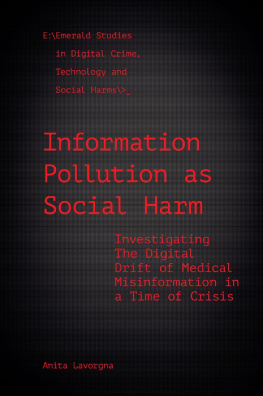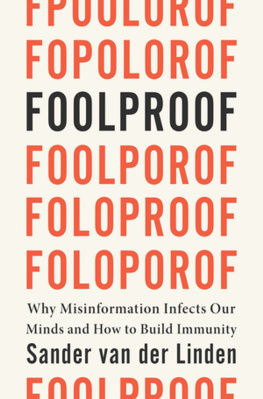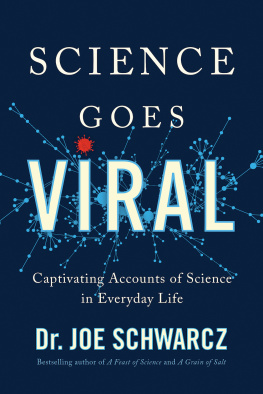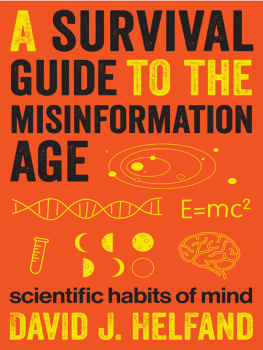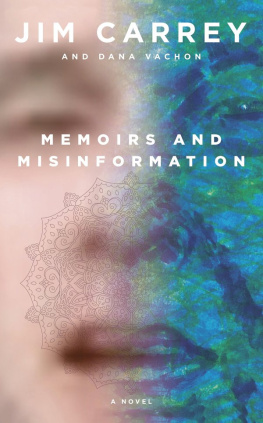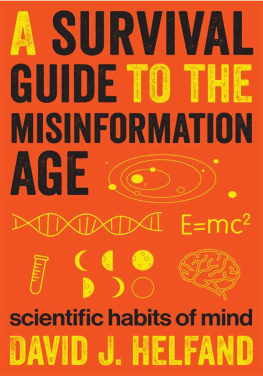Information, a series edited by Andrew Dillon
Misinformation and Mass Audiences
EDITED BY BRIAN G. SOUTHWELL, EMILY A. THORSON, AND LAURA SHEBLE

University of Texas Press
Austin
Copyright 2018 by the University of Texas Press
All rights reserved
First edition, 2018
Requests for permission to reproduce material from this work should be sent to:
Permissions
University of Texas Press
P. O. Box 7819
Austin, TX 78713-7819
utpress.utexas.edu/rp-form
Library of Congress Cataloging-in-Publication Data
Names: Southwell, Brian G. (Brian Glen), 1974, editor. | Thorson, Emily A., editor. | Sheble, Laura, editor.
Title: Misinformation and mass audiences / edited by Brian G. Southwell, Emily A. Thorson, and Laura Sheble.
Description: First edition. | Austin : University of Texas Press, 2018. | Series: Information | Includes bibliographical references and index.
Identifiers: LCCN 2017025953
ISBN 978-1-4773-1455-5 (cloth : alk. paper)
ISBN 978-1-4773-1456-2 (pbk. : alk. paper)
ISBN 978-1-4773-1457-9 (library e-book)
ISBN 978-1-4773-1458-6 (non-library e-book)
Subjects: LCSH: Mass mediaAudiences. | Communication. | Common fallaciesSocial aspects. | Deceptive advertisingSocial aspects.
Classification: LCC P91.27 .M57 2018 | DDC 302.23dc23
LC record available at https://lccn.loc.gov/2017025953
doi:10.7560/314555
Contents
BRIAN G. SOUTHWELL, EMILY A. THORSON, AND LAURA SHEBLE
ELIZABETH J. MARSH AND BRENDA W. YANG
VANESSA BOUDEWYNS, BRIAN G. SOUTHWELL, KEVIN R. BETTS, CATHERINE SLOTA GUPTA, RYAN S. PAQUIN, AMIE C. ODONOGHUE, AND NATASHA VAZQUEZ
JOSEPH N. CAPPELLA, YOTAM OPHIR, AND JAZMYNE SUTTON
DOUGLAS J. AHLER AND GAURAV SOOD
JEFF HEMSLEY AND JAIME SNYDER
MELANIE C. GREEN AND JOHN K. DONAHUE
DANNAGAL G. YOUNG
BRIAN E. WEEKS
LAURA SHEBLE
ALEXANDER MAKI, AMANDA R. CARRICO, AND MICHAEL P. VANDENBERGH
BRIONY SWIRE AND ULLRICH ECKER
GRAHAM BULLOCK
SHANNON POULSEN AND DANNAGAL G. YOUNG
EMILY A. THORSON
JEFF HEMSLEY
SAMANTHA KAPLAN
EMILY A. THORSON, LAURA SHEBLE, AND BRIAN G. SOUTHWELL
Acknowledgments
This project reflects the work of many authors, both those listed formally and others who helped behind the scenes. Collectively, we would like to thank the external reviewers as well as the University of Texas Press for their enthusiastic help in constructing this volume, especially Robert Devens, Sarah McGavick, and Lynne Chapman, and series editor Andrew Dillon at the University of Texas, who with a light hand nurtured this project as it grew. Many thanks also to freelance copyeditor Tana Silva, indexer Lisa Rivero, and proofreader Melissa McGee Tullos for their outstanding work.
In addition, Brian is grateful for the ongoing patience and support of his family, including Jessica, Gavin, and Ellerie. Emily would like to thank her family and coeditors. Laura thanks her family and friends for their encouragement and uncanny ability to know perfectly just when to share a joke, a walk, a sandwichand especially their time. We would also like to thank all who have contributed to our understanding of misinformation. Finally, we thank those who are reading these pages for your interest in joining this conversation.
INTRODUCTION
Misinformation among Mass Audiences as a Focus for Inquiry
BRIAN G. SOUTHWELL, EMILY A. THORSON, AND LAURA SHEBLE
Misinformationboth deliberately promoted and accidentally sharedis a noteworthy and perhaps inevitable part of the world in which we live. People likely have lied to one another for roughly as long as verbal communication has existed. Deceiving others can offer an apparent opportunity to gain strategic advantage, to motivate others to action, or even to protect interpersonal bonds. Moreover, people inadvertently have been sharing inaccurate information with one another for thousands of years. We currently live in an era of mass audiences, however, which means that the potential for immediate and widespread misinformation effects now looms larger than in the past. Yet in those same patterns of mass communication and facilitated peer-to-peer information spread might also be the seeds of misinformation correction over time. Investigating the spread and effects of misinformation is as compelling now as it has ever been in human history.
As a focus for research and debate, the phenomenon of misinformation crosses disciplinary bounds; misinformation exists in and across topical domains, from science to politics to consumer advertising, and can quickly spread through a range of media, including television, radio, and pixels shared via social media on the Internet. Understanding misinformation requires working at many levels of analysis, from the policy infrastructure for mass media content to individual information processing ability. Thoroughly understanding and addressing the proliferation, effects, and correction of misinformation calls for a multidisciplinary approach.
In assembling this collection of essays, we have brought together evidence and ideas from communication research, public health, psychology, political science, environmental studies, information science, and other literatures to explore what constitutes misinformation, how it spreads, and how best to counter it. We consider various angles, such as the extent to which audiences consciously notice misinformation, possibilities for audience deception, the ethics of satire in journalism and public affairs programming, the diffusion of rumors, the role of Internet search behavior, and the development of efforts such as fact-checking programs.
Curation of a broad sweep of ideas related to misinformation admittedly risks creation of a smorgasbord that lacks useful argument and thematic coherence. In light of that risk, we have organized contributions into three types of essaysconceptualization and measurement of individual engagement with misinformation, discussion of potential effects, and exploration of remediesand also have accepted some framing assumptions and boundaries as to what we can discuss in this book and what is best left for future exploration. The consequence of that is a book that simultaneously reminds us that misinformation will continue to pose a dilemma for mass media systems for the foreseeable future and that there are ways we can address concerns. Below, we argue that misinformation exists, that it is problematic in the context of mass audiences and societies for particular reasons, and that the essays we have selected contribute in different ways to thought in this arena, an arena we claim is a worthy one for future inquiry, policy making, and public discussion.
What Is Misinformation?
Misinformation is concerning because of its potential to unduly influence attitudes and behavior, leading people to think and act differently than they would if they were correctly informed. In other words, we worry that misinformation (or false information) might lead people to hold misperceptions (or false beliefs) and that these misperceptions, especially when they occur among mass audiences, may have downstream consequences for health, social harmony, and political life.
Here we are assuming the common existence of mass audiences as Price (1992) and Webster and Phalen (1996) have defined them: more than a dyad or family unit and large enough that members do not necessarily communicate with one another directly but rather are connected primarily through exposure to a common message or piece of information. The possibility that
Next page

